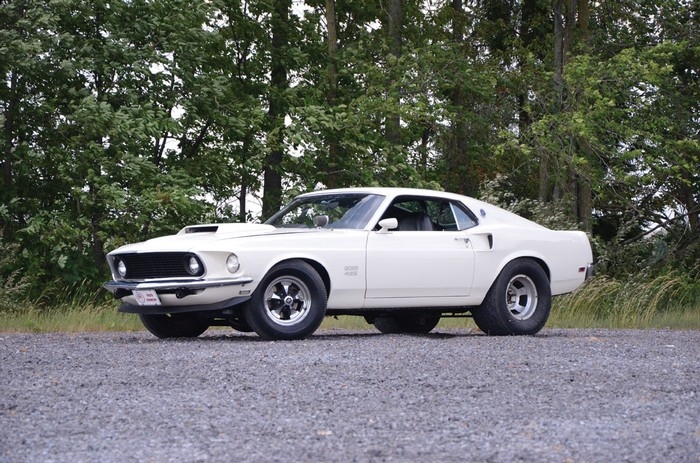SCM Analysis
Detailing
| Vehicle: | 1969 Ford Mustang Boss 429 |
| Years Produced: | 1969–70 |
| Number Produced: | 857 (1969), 500 (1970) |
| Original List Price: | $4,798 |
| SCM Valuation: | $175,000–$220,000 |
| Tune Up Cost: | $500 |
| Distributor Caps: | $17 |
| Chassis Number Location: | Kar Kraft number on foil decal on inside of driver’s door above Ford VIN/trim tab |
| Engine Number Location: | Kar Kraft number on rear of engine block |
| Club Info: | Mustang Club of America |
| Website: | www.mustang.org |
| Alternatives: | 1970–71 Plymouth Hemi ’Cuda, 1969–70 Ford Mustang 428 SCJ, 1969 Chevrolet Camaro ZL1 |
| Investment Grade: | A |
This 1969 Boss 429, Lot 4103, sold for $145,750, including buyer’s premium, at Auctions America by RM’s Auburn Fall sale on August 30–September 2, 2012.
That price was well below the pre-auction estimate of $150k–$200k, and about two-thirds the money that fully detailed and restored models have recently brought in the current market. Although this particular example has reportedly navigated its way through the past 43 years one quarter mile at a time, its value may reach far beyond a dollar amount.
Oval track mill
The Boss 429 was put into production to fulfill NASCAR’s homologation requirements, so a minimum of 500 examples of Ford’s “semi-Hemi” monster needed to find their way onto a production line. Interestingly, Ford execs chose not to plant the engine in the sales-lot version of the mid-sized Torino, the model that would be powered by the Boss on NASCAR’s super-speedways, but instead chose to plunk 857 of the high-revving terrors into the cramped confines of their ailing golden goose, the Mustang.
By 1970, production numbers for the Mustang had dropped fairly dramatically since its booming introduction only a few years prior. In just five years, the car had grown in almost every quantifiable dimension, and by 1969, it was being criticized for having grown out without having grown up.
The simple, lightweight pony that had revolutionized the industry had slowly morphed into a boy racer’s pinup, and in the process had lost much of the broad appeal that had made the car an instant classic. With new segment competitors threatening to out-muscle the Mustang, Ford desperately needed to provide the horsepower-addicted public with something new to be excited about. Dropping in the 429 seemed like the perfect answer, at least on paper.
A deserving legend?
Although the Boss has become one of the most highly prized heroes of the mountain motor era, its initial performance was somewhat less than deserving of the legend it would come to inspire. The implied performance promised by the pairing of all those cubes and a lightweight wrapper was foiled by a simple confusion of purpose.
Detroit’s Big Three were battling for national supremacy one stoplight at a time, and consumers believed the Boss to be a mighty quarter-mile weapon. However, the Boss 429 was designed for an entirely different purpose. The big engine was bred to rev, and inherently lacked the dramatic low-end punch that critics expected. Lackluster performance was even more dramatic in the earliest ’69 cars, due to the installation of improper valve springs that severely limited the engine’s ability to find the revs it so desperately needed.
According to the literature associated with our sale, this car’s original owner began clarifying his purpose almost immediately after taking possession. The addition of a new cam, carb, shocks, and gears immediately and dramatically lifted the Boss’s performance, dropped its E.T., and earned it a legitimate magazine feature, but at what long-term expense?
A reason to believe
The Boss 429 earns the big bucks for two basic reasons: exclusivity and legacy. Ford ensured the Boss’ exclusivity with low, although by no means ultra-low, production numbers. The Boss’s legacy, that most elusive and intoxicating factor of value, required significantly more effort to establish.
Performances, real or exaggerated, by lightly modified cars such as our subject surely contributed heavily to that legacy. Because underperformers, as the early Bosses surely were, are rarely forgiven in the lexicon of collectible automobiles, the value of proven cars that actually deliver what the manufacturers implied may be historically more important than many of us are willing to admit.
Is a bone-stock, no-mileage, fully documented car more valuable than one with a lifetime of street cred and a penchant for punishment? Absolutely. But the real question should be, where does the line between a stock underachiever and a sorted-out, mostly stock monster blur?
Is our subject Boss 429 mostly stock with the most important bits accounted for? You bet. Will it completely humiliate a stocker that cost 50% to 75% more where it really counts, in a straight line? I’d be willing to bet the farm on it.
Was it a good buy?
While our car’s value may be at the lower end of the Boss spectrum, there is absolutely no reason to expect that value to decrease in the foreseeable future. So as a usable high-performance Boss, this was a deal at the price paid.
I wouldn’t advise the new owner to shell out the cash for a restoration any time soon, especially if the car has as much life left in it as appears on the surface. But there will come a time when he’ll have to make that call. And it’ll be an expensive decision, as there will undoubtedly be some rare missing pieces he’ll need to source to make it as right as some of the other top-dollar cars we’ve seen lately.
But until that time, the new owner has a real Boss 429 that can annihilate rubber and devour city blocks at a rate worthy of its reputation. And isn’t that the whole point?
(Introductory description courtesy of Auctions America by RM.)
